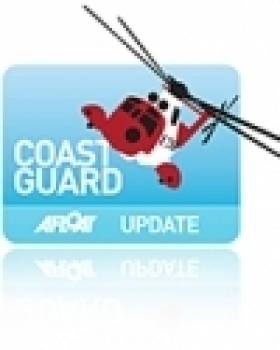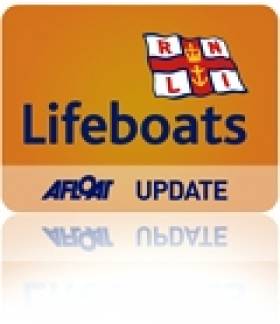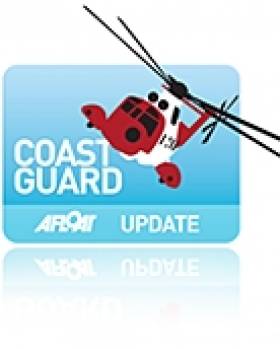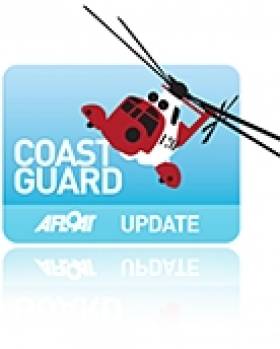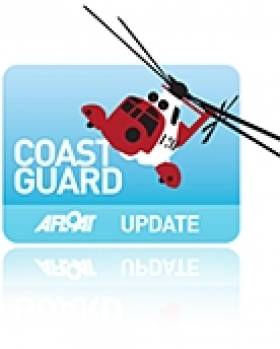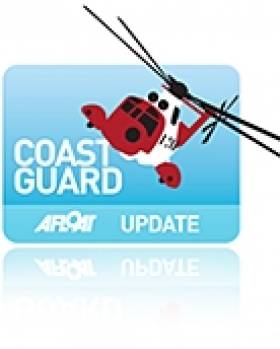Displaying items by tag: helicopter
Warning Issued as Logs Fall from Vessel off South East Coast
The Waterford-based Coast Guard helicopter has already investigated and some of the cargo has washed up on the south east coast. The vessel was on passage from Portavogie (Scotland) to Youghal, when the incident occurred.
Weather conditions in the area are winds south westerly force 5/6 with moderate visibility. A navigation warning has been issued to vessels in the area.
Ballycotton Lifeboat Launches for Pleasure Craft in Choppy Seas
Ballycotton RNLI lifeboat was launched at 12:10 today for a pleasure craft in the Ballycotton Bay area of East Cork.
No contact had been made with the lone sailor for over an hour and his concerned family contacted the Coast Guard.
Sea conditions in the area was choppy at the time, with the wind blowing North East force 6/7.
The Ballycotton RNLI lifeboat, Austin Lidbury, were requested to launch, as were the Ballycotton Coast Guard unit and the Waterford based Coast Guard helicopter, Rescue 117.
The pleasure craft returned safely to shore under its own power shortly afterwards and the emergency units were stood down.
Related Safety posts
RNLI Lifeboats in Ireland
Safety News
Rescue News from RNLI Lifeboats in Ireland
Coast Guard News from Ireland
Water Safety News from Ireland
Marine Casualty Investigation Board News
Marine Warnings
Woman Airlifted From Beach After Fall
The woman who was staying at Manorbier, had fallen near to a cave and was now on rocks to the west of the beach. Her young son (aged 11) was with her at the time along with another youngster, aged 14. The tide was coming in and there was no access out of the area, which allowed her evacuation from the area only by sea. Another member of the public who had witnessed the accident called the Coastguard for assistance.
The Tenby Coastguard Rescue Team were immediately turned out and the RNLI Tenby All weather Lifeboat with their 'Y' boat on board was also asked to launch. A rescue helicopter from RAF Chivenor was also scrambled given the inaccessibility of the area.
The weather on scene late this afternoon was southwesterly winds force 5 to 7 with moderate seas and squally showers.
From reports at the beach it was decided that conditions were too rough to effect either a cliff rescue or sea evacuation and the rescue helicopter landed on the beach and administered first aid to the woman who was in acute pain. It then took all three people off to Withybush hospital.
Nigel Yelland, Watch manager at Milford Haven Coastguard said
"The area in which the woman was exploring can be quite challenging in wet weather, and rocks can become very slippery underfoot. We're advising that as the autumnal weather becomes more hostile please wear the most appropriate clothing and footwear for the coastal areas you intend to walk, and make sure you have some method of communication to the outside world."
Three Die in Cruiser Fire off West Cork
Three men are dead and a fourth has been injured after a boat went on fire and sank off the West Cork coast this evening. It happened in waters south of Roundcarrig Lighthouse off Adrigole Harbour, Bantry Bay. It is understood a serious fire broke out on the 25-foot cruiser. The RNLI lifeboat went to the cruiser's rescue at 5.45pm. There is no information currently about the type of cruiser involved.

Photo: courtesy of Castletownbere lifeboat
A Coast Guard helicopter spotted the men in the water. The boat was on fire and sinking as they arrived.
The bodies of the three victims have been removed to hospital. It is understood all four men, who were in their 60s, were living in the Glengarriff area.
One of the victims is Irish and the other two men are from other European countries. A fourth man, who survived the incident, has also been taken to hospital.
The boat sank a short while later off Roancarrig, about seven miles from the fishing port. Conditions were calm at the time with some light fog in the bay, the spokeswoman said. Officials from the Marine Casualty Investigation Board will carry out an inquiry into the incident.
It is understood investigations will centre on whether an explosion in the engine caused the fire.
Press Release from RNLI:
Lifeboat crew with Castletownbere RNLI responded to a callout out this evening (Monday 16 August 2010) to a 25-foot cruiser on fire seven miles off the coast of Castletownbere, off Adrigole Harbour in Bantry Bay. The Shannon based Coast Guard helicopter was on scene and recovered four casualties from the water. Three were pronounced dead and one was taken to Cork University hospital for treatment.The Castletownbere all weather lifeboat was requested to launch at 17.41 hrs in calm conditions. On arrival at the scene the lifeboat volunteers witnessed the vessel on fire and the CG helicopter was recovering the casualties from the water. The Shannon based helicopter had been out on a callout and was in the area. The lifeboat was designated on scene commander and stayed on scene until the burning cruiser sank.
The contract, will provide SAR services from bases at Waterford, Dublin, Shannon and Sligo from 2012 onwards. CHC already provides SAR services from these bases but the new contract will see the existing fleet of S-61N aircraft replaced with newer Sikorsky S-92A helicopters that are custom fitted for SAR work.
Irish Coast Guard Director Chris Reynolds said, "The Irish Coast Guard provides a diverse range of maritime and land-based SAR activities, ranging from national emergency situations such as the recent flooding seen in Ireland last winter to medevac from our Islands, mountains, fishing vessels and incidents involving leisure activity."
"It is essential we have the right stepped increase in capabilities going forward for the next decade. We are very confident in selecting CHC Helicopter that our decision will continue to deliver excellence, providing the most efficient and effective SAR service for Ireland."
The Irish contract cements CHC Helicopter's position as a world leader in provision of civilian SAR services. In addition to the service already provided in Ireland, CHC currently provides SAR coverage in Australia and the UK, and through its membership in the Soteria consortium, has been identified as the preferred bidder on the UK SAR-H program, a 25-year contract to provide helicopter-based SAR services from 12 bases throughout the UK.
"CHC is internationally recognised as a provider of effective SAR solutions to customers worldwide. In today's very challenging environment, we offer the most efficient, reliable and effective services using industry leading technology," said Tilmann Gabriel, chairman of CHC Ireland and president of CHC Helicopter's European Operations.
Mark Kelly, Managing Director of CHC Ireland, added that Irish citizens could now expect to see many positive changes arise.
"Over the next decade this contract will offer a number of service improvements including the ability to deliver a paramedic to any SAR incident within an hour anywhere on our coastline, ensuring much faster treatment of casualties," he said.
CHC is the world's largest operator of the Sikorsky S-92 helicopter that has a long and distinguished pedigree in SAR operations. There are currently more than 100 S-92 helicopters in operation around the world with a fleet total approaching 250,000 flight-hours.
The state-of-the-art twin-engine aircraft will be specially equipped for SAR operations and capable of flying faster and farther than aircraft currently in use. As well as longer range and improved cruising speeds, the S-92s will be equipped with enhanced rescue mission technology including infra-red and low light cameras, a Nightsun searchlight, a satellite communications system featuring a Flight Following tracking facility, and high speed dual hoists.
Helicopter Crew Commended For Dramatic Air-Sea Rescue
The crew of an emergency search and rescue helicopter has been awarded the Best of Irish Award for rescuing a stricken pilot when his light aircraft crashed into the Irish Sea.
The six-strong crew of R117, employed by CHC Helicopter and based at Waterford, was presented with the accolade at the awards which took place at the Burlington Hotel in Dublin last night.
The star-studded ceremony, which also saw the Irish Rugby team recognised for their outstanding win at the 2009 RBS Six Nations tournament, celebrates those who have excelled in the past year and contributed in a positive way to the people of Ireland.
Captain Dara Fitzpatrick, co-pilot Ronan Flanagan, winch operator Neville Murphy and winchman Keith Devaney were all present to collect the award. The remaining members of the team, engineers Martin Dennehy and Colm McCloughry, were unable to attend.
“We are delighted and honoured to have been presented with this award which is really the cherry on the cake for us,” said Capt Fitzpatrick.
“When you hear a report of an aircraft ditching in the sea you immediately think worst-case scenario. We didn’t know what we were facing so to have been able to retrieve a casualty alive from the water was fantastic.”
The team was returning from a training exercise when they were alerted to a mayday call at around 5pm on August 11, last year.
The crew the British Orchid Atlantic rowing boat, who were navigating round Britain, called the Coast Guard after seeing an aircraft crash into the water at Tuskar Rock, off the South Wexford coast.
Low on fuel, the S61 rescue helicopter quickly landed, refuelled and was on route to the scene within 10 minutes. As they made their way to the location, reports were received of wreckage in the water and a suspected survivor.
On arrival, they saw the pilot standing waist-deep in water on the wing of the stricken craft which was rapidly succumbing to the waves. Winchman Keith Devaney was lowered down and was able to secure the man and winch him to safety moments before the single-engine aircraft sank.
The sole occupant of the plane, which was being flown from England to Wexford, the pilot was flown to shore and taken by ambulance to hospital. Despite his ordeal, he had miraculously escaped serious injury.
“In terms of technical challenges we have had to deal with some far tougher jobs,” added Capt Fitzpatrick.
“We were fortunate that the conditions were relatively calm and that the pilot hadn’t suffered any serious injuries on impact. Combined with the extensive mission training we undergo, these factors made for a textbook rescue.”
Chris Reynolds, Director of the Irish Coast Guard said: “I am pleased to see the men and women of the Irish Coast Guard recognised for their professionalism. The service operates 365 days a year in all types of conditions and this award is testament to the continued hard work, training and commitment of the whole team.”
Noel Dempsey, Ireland’s Minister for Transport, also praised the team for their heroic efforts.
“I warmly congratulate the Waterford Coast Guard helicopter crew, for a very well-deserved award,” he said.
“The speed at which they responded to this incident, assessed the scene and acted, certainly helped save a life. But this award isn't just for the crew on the Waterford helicopter that day though.
“It's for all of their backroom team, including the engineers who ensure that our aircrafts are safe to fly, our replacement crews, and everyone who supports the work of the Waterford team, and all our other teams around the country.
“Each day hundreds of Coast Guard crews, whether in lifeboats, helicopters or involved in our other patrols around the coastline, selflessly put their lives at risk in the service of others.
“I want to commend you all and thank you, on behalf of the Government for your role in this important, lifesaving work. Well done again.”
Major Air and Sea Search Called off
Following a report of a flare tonight, an extensive search of an area west of Cork Harbour was conducted but nothing was found and the search was called off. Emergency services had received reports of a red flare seen at Rocky Bay, west of Cork Harbour. RNLI lifeboats from Kinsale, Crosshaven and Ballycotton and the Waterford based Coastguard helicopter, Rescue 117, were launched to investigate the sightings.


























